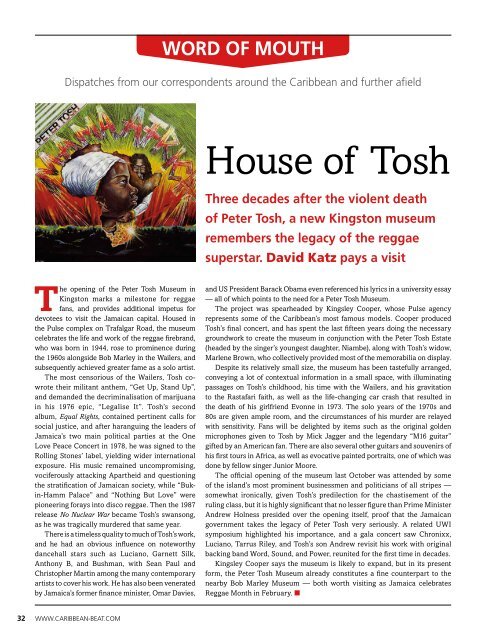Caribbean Beat — January/February 2017 (#143)
A calendar of events; music, film, and book reviews; travel features; people profiles, and much more.
A calendar of events; music, film, and book reviews; travel features; people profiles, and much more.
You also want an ePaper? Increase the reach of your titles
YUMPU automatically turns print PDFs into web optimized ePapers that Google loves.
word of mouth<br />
Dispatches from our correspondents around the <strong>Caribbean</strong> and further afield<br />
House of Tosh<br />
Three decades after the violent death<br />
of Peter Tosh, a new Kingston museum<br />
remembers the legacy of the reggae<br />
superstar. David Katz pays a visit<br />
The opening of the Peter Tosh Museum in<br />
Kingston marks a milestone for reggae<br />
fans, and provides additional impetus for<br />
devotees to visit the Jamaican capital. Housed in<br />
the Pulse complex on Trafalgar Road, the museum<br />
celebrates the life and work of the reggae firebrand,<br />
who was born in 1944, rose to prominence during<br />
the 1960s alongside Bob Marley in the Wailers, and<br />
subsequently achieved greater fame as a solo artist.<br />
The most censorious of the Wailers, Tosh cowrote<br />
their militant anthem, “Get Up, Stand Up”,<br />
and demanded the decriminalisation of marijuana<br />
in his 1976 epic, “Legalise It”. Tosh’s second<br />
album, Equal Rights, contained pertinent calls for<br />
social justice, and after haranguing the leaders of<br />
Jamaica’s two main political parties at the One<br />
Love Peace Concert in 1978, he was signed to the<br />
Rolling Stones’ label, yielding wider international<br />
exposure. His music remained uncompromising,<br />
vociferously attacking Apartheid and questioning<br />
the stratification of Jamaican society, while “Bukin-Hamm<br />
Palace” and “Nothing But Love” were<br />
pioneering forays into disco reggae. Then the 1987<br />
release No Nuclear War became Tosh’s swansong,<br />
as he was tragically murdered that same year.<br />
There is a timeless quality to much of Tosh’s work,<br />
and he had an obvious influence on noteworthy<br />
dancehall stars such as Luciano, Garnett Silk,<br />
Anthony B, and Bushman, with Sean Paul and<br />
Christopher Martin among the many contemporary<br />
artists to cover his work. He has also been venerated<br />
by Jamaica’s former finance minister, Omar Davies,<br />
and US President Barack Obama even referenced his lyrics in a university essay<br />
<strong>—</strong> all of which points to the need for a Peter Tosh Museum.<br />
The project was spearheaded by Kingsley Cooper, whose Pulse agency<br />
represents some of the <strong>Caribbean</strong>’s most famous models. Cooper produced<br />
Tosh’s final concert, and has spent the last fifteen years doing the necessary<br />
groundwork to create the museum in conjunction with the Peter Tosh Estate<br />
(headed by the singer’s youngest daughter, Niambe), along with Tosh’s widow,<br />
Marlene Brown, who collectively provided most of the memorabilia on display.<br />
Despite its relatively small size, the museum has been tastefully arranged,<br />
conveying a lot of contextual information in a small space, with illuminating<br />
passages on Tosh’s childhood, his time with the Wailers, and his gravitation<br />
to the Rastafari faith, as well as the life-changing car crash that resulted in<br />
the death of his girlfriend Evonne in 1973. The solo years of the 1970s and<br />
80s are given ample room, and the circumstances of his murder are relayed<br />
with sensitivity. Fans will be delighted by items such as the original golden<br />
microphones given to Tosh by Mick Jagger and the legendary “M16 guitar”<br />
gifted by an American fan. There are also several other guitars and souvenirs of<br />
his first tours in Africa, as well as evocative painted portraits, one of which was<br />
done by fellow singer Junior Moore.<br />
The official opening of the museum last October was attended by some<br />
of the island’s most prominent businessmen and politicians of all stripes <strong>—</strong><br />
somewhat ironically, given Tosh’s predilection for the chastisement of the<br />
ruling class, but it is highly significant that no lesser figure than Prime Minister<br />
Andrew Holness presided over the opening itself, proof that the Jamaican<br />
government takes the legacy of Peter Tosh very seriously. A related UWI<br />
symposium highlighted his importance, and a gala concert saw Chronixx,<br />
Luciano, Tarrus Riley, and Tosh’s son Andrew revisit his work with original<br />
backing band Word, Sound, and Power, reunited for the first time in decades.<br />
Kingsley Cooper says the museum is likely to expand, but in its present<br />
form, the Peter Tosh Museum already constitutes a fine counterpart to the<br />
nearby Bob Marley Museum <strong>—</strong> both worth visiting as Jamaica celebrates<br />
Reggae Month in <strong>February</strong>. n<br />
32 WWW.CARIBBEAN-BEAT.COM


















